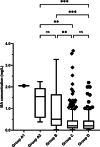Methylamphetamine toxicity and its involvement in death: A retrospective observational study of deaths reported to the Victorian Coroner, Australia
- PMID: 37792205
- PMCID: PMC11525310
- DOI: 10.1007/s12024-023-00724-0
Methylamphetamine toxicity and its involvement in death: A retrospective observational study of deaths reported to the Victorian Coroner, Australia
Abstract
A retrospective observational study of Victorian deaths involving MA between 2010 and 2019 was conducted to determine the prevalence and contribution of methylamphetamine (MA) toxicity to death in the absence of other factors. Demographics, autopsy findings, toxicology, and the cause of death were reviewed. Coronial cases were categorized into five groups: deaths due to MA toxicity in the absence of other factors (Group A1); deaths due to MA toxicity in the setting of other potentially contributing factors (Group A2); deaths due to MA toxicity in the setting of significant natural disease (Group B); deaths primarily due to multiple-drug toxicity (Group C); and deaths primarily due to natural causes (Group D). There were 506 deaths involving MA categorized into Group A1 (n = 1, 0.6%), Group A2 (n = 8, 1.6%), Group B (n = 28, 5.5%), Group C (n = 229, 45%), and Group D (n = 240, 47%). Significant natural disease was prevalent among deaths involving MA and mainly concerned forms of cardiovascular disease (n = 277, 55%). The MA concentration in the one death included in Group A1 was 2.1 mg/L. The median MA concentrations of Group A2 (1.6 mg/L) and Group B (0.5 mg/L) were significantly higher than Group C (0.2 mg/L) and Group D (0.2 mg/L). Additionally, many other toxicologically significant drugs were detected and mostly comprised of central nervous system depressants. Deaths due to MA toxicity in the absence of other factors were rare despite the greater availability of crystal MA in the Australian community. The study highlights the interpretative challenges of MA blood concentrations and the continuing harms of this drug in Australia.
Keywords: Amphetamines; Cause of Death; Central Nervous System Stimulants; Forensic Pathology; Forensic Toxicology; Methylamphetamine; Sudden Cardiac Death.
© 2023. The Author(s).
Conflict of interest statement
The authors declare no competing interests.
Figures


Similar articles
-
A retrospective review of methylamphetamine detected in child deaths reported to the Victorian Coroner, Australia.Forensic Sci Med Pathol. 2024 Dec;20(4):1261-1267. doi: 10.1007/s12024-024-00778-8. Epub 2024 Jan 19. Forensic Sci Med Pathol. 2024. PMID: 38240995 Free PMC article.
-
Cocaine in sudden and unexpected death: a review of 49 post-mortem cases.Forensic Sci Int. 2013 Apr 10;227(1-3):52-9. doi: 10.1016/j.forsciint.2012.08.037. Epub 2012 Sep 13. Forensic Sci Int. 2013. PMID: 22981213
-
Clinical and Autopsy Characteristics of Fatal Methamphetamine Toxicity in Australia.J Forensic Sci. 2018 Sep;63(5):1466-1471. doi: 10.1111/1556-4029.13710. Epub 2017 Nov 29. J Forensic Sci. 2018. PMID: 29193063
-
[Mechanism of methamphetamine intoxication and its medical identification].Fa Yi Xue Za Zhi. 2012 Apr;28(2):126-9. Fa Yi Xue Za Zhi. 2012. PMID: 22619810 Review. Chinese.
-
Methamphetamine-related forensic autopsy cases in a Japanese prefecture over a 7-year period: Characteristics of deaths and blood concentrations.Leg Med (Tokyo). 2023 Feb;60:102181. doi: 10.1016/j.legalmed.2022.102181. Epub 2022 Dec 1. Leg Med (Tokyo). 2023. PMID: 36470025 Review.
Cited by
-
Is methamphetamine blood concentration in emergency department patients associated with the clinical picture?Addiction. 2025 May;120(5):1007-1015. doi: 10.1111/add.16765. Epub 2025 Jan 20. Addiction. 2025. PMID: 39829384 Free PMC article.
-
The analysis of methylamphetamine and para-hydroxy-methylamphetamine in post-mortem hair samples using liquid chromatography-tandem mass spectrometry.Drug Test Anal. 2025 Apr;17(4):544-554. doi: 10.1002/dta.3765. Epub 2024 Jul 1. Drug Test Anal. 2025. PMID: 38949034 Free PMC article.
References
-
- Rothman RB, Baumann MH. Monoamine transporters and psychostimulant drugs. Eur J Pharmacol. 2003;479(1–3):23–40. 10.1016/j.ejphar.2003.08.054. - PubMed
-
- European Monitoring Centre for Drugs and Drug Addiction (EMCDDA). Methamphetamine drug profile. [Available from: https://www.emcdda.europa.eu/publications/drug-profiles/methamphetamine_en].
-
- Cruickshank CC, Dyer KR. A review of the clinical pharmacology of methamphetamine. Addiction. 2009;104(7):1085–99. 10.1111/j.1360-0443.2009.02564.x. - PubMed
-
- Degenhardt L, Sara G, McKetin R, Roxburgh A, Dobbins T, Farrell M, et al. Crystalline methamphetamine use and methamphetamine-related harms in Australia. Drug Alcohol Rev. 2017;36(2):160–70. 10.1111/dar.12426. - PubMed
Publication types
MeSH terms
Substances
Grants and funding
LinkOut - more resources
Full Text Sources
Medical

